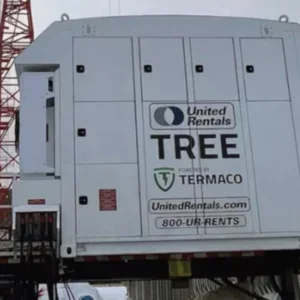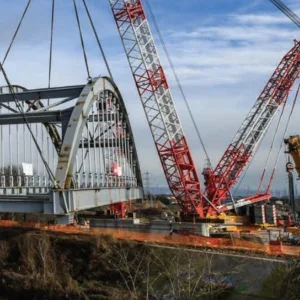After almost a century of crane safety systems we are at a point where it is standard practice for a crane to be equipped with a combination of electronic systems intended to improve safety or effectiveness.
Electronic controls and safety systems on state-of-the-art mobile construction equipment are either one large integrated package or a group of individual subsystems. These electronics have become the movers in the background that allow machines to work more efficiently than ever before while at the same time being much safer. Ever increasing computer power allows the monitoring of machine parameters such as engine data, geometry, setup and load, in addition to environmental parameters such as wind speed. Working together with the control system that drives every part of the machine, these computers help the operator stay on top of the complicated demands of today’s jobs.
Software is becoming more and more important, allowing the systems to go beyond the immediate operation that is taking place. Systems can also record data which supports crane owners in effective fleet management of their valuable investment. And, before the job is even started, crane selection and lift planning software can be used to help select the right tools for the job and then carry out the lift in the most effective and timely manner. During the lift telecommunication hard- and software allows remote monitoring of the work, while on-board systems such as rated capacity limiters or outrigger monitoring systems help the operator make sure his lift is safe.
What’s next?
All the systems mentioned above are readily available and can be found in modern cranes, to varying degrees of sophistication, but what might future developments be? Future development will be triggered by two major influences: application requirements and new technologies. Both factors are derived from different directions. Application requirements come directly from the expectations of machine users whereas the new technologies usually stem from unrelated developments in computer and consumer technology, for example, that is providing more and more new technologies. The trick has been, and will continue to be, to combine them successfully: define applications that use those latest technologies that bring a benefit to the machines’ applications. Those applications are centred around requirements that include efficiency, machine life, operator safety, equipment, surrounding personnel and the environment. Continuing to influence development will be wireless technologies, networking, sensor technology, GPS and display technology. As in all other areas of high technology, cost pressure and the ever-increasing power of computers encourages and forces the crane industry to explore innovative solutions.
Bus technology is replacing conventional wiring in the automotive industry and it is being seen more and more in the crane industry. Evolving as the most popular standard is CAN-Bus, created by Bosch for automotive environments and therefore also suitable for the construction equipment industry. Benefits to manufacturers are reduced wiring, advanced trouble-shooting capabilities and heightened resistance to electromagnetic interference. But the benefits go way beyond that. As a brand-independent standard, CAN-Bus means easy integration: safety systems, control systems, engines, transmissions, etc. can all ‘talk’ to each other, which gives new application possibilities. And all this is possible without being forced to have just a single supplier of all those systems. CAN-Bus is an example of a technology that, on its own merits, is in the process of replacing another one (conventional wiring) but at the same time also opens up a new range of applications that were almost impossible before.
Wireless technology is in a similar position. Its use on machinery is increasing, first in the form of remote controls, and also as a replacement for wires where cables are either difficult to apply or even more costly than a radio system. But again the possibilities will go further than that. Wireless technology opens the door to inter-vehicle communication – mobile machines exchanging information – and that will in turn allow totally new areas of application.
The most common form of communication between mobile machinery and its environment is the mobile telephone, now installed in many machines. Beyond the obvious use, for human communication, a mobile phone enables on-board systems to communicate with their computer counterparts anywhere in the world. Applications are remote control and trouble-shooting, commissioning and fleet management. Machines equipped with such systems can be monitored from a remote office and thereby managed efficiently. If the machine is also equipped with a GPS system, its location can also be monitored – theft detection is just one of the possible applications for this technology.
While most technologies have been concerned with protecting the operator or the machine, new ones are extending that and making a machine’s immediate surrounding area a safer place to work in. At this year’s ConExpo show in Las Vegas PAT launched a new range of motion alert systems that give visual and audible warnings to ground personnel working at the same construction site as the machine. The system can be mounted on the load being moved, on the hook block or on any protruding or moving part of the machine, counterweights, for example, and triggers its warning alarm either on command by the operator or automatically by sensing the motion of the machine.
In the consumer orientated computer industry wireless ad-hoc networks are getting stronger and stronger. Technologies such as wireless Ethernet (WiFi Standard) and Blue Tooth are making their way into the daily lives of computer users. The interesting thing about this technology is that it allows users to log into an existing network without having to add any infrastructure. In an office this means users come in with laptops that are automatically logged in to the wireless office network without having to connect to any outlets. For the construction industry this implies that we could have construction sites with wireless networks and any machine entering the premises is automatically logged into this network. That could be used to enhance safety and to improve the efficiency of the whole jobsite. Or machines could recognise each other and exchange data by using the same technology in a so-called peer-to-peer configuration, even on construction sites that would not yet be equipped with the networking infrastructure.
Too far out? It is just a matter of a few years until we will see those applications begin to emerge. It will mainly depend on the equipment manufacturers joining forces to develop standards early on. In a future world of networked machinery, be it on-board or between machines and their environment, an open standard is the absolute necessity to make this happen. To do this an industry panel must be formed with some of the major players involved. The panel would have the task to evaluate existing standards such as 802.11a or Blue Tooth for applicability. Based on the panel’s expertise the result would be either the recommendation of an existing standard or the requirements for creation of a new standard. The earlier the process starts, the sooner a consensus can be reached that will speed up the introduction of the technology and save everybody money in the longer run. The danger of not having such a recommendation is that various manufacturers will apply different technologies and/or standards and machines will not be compatible – that of course would completely defy the purpose of the whole idea of a wireless information interchange network for construction equipment.






